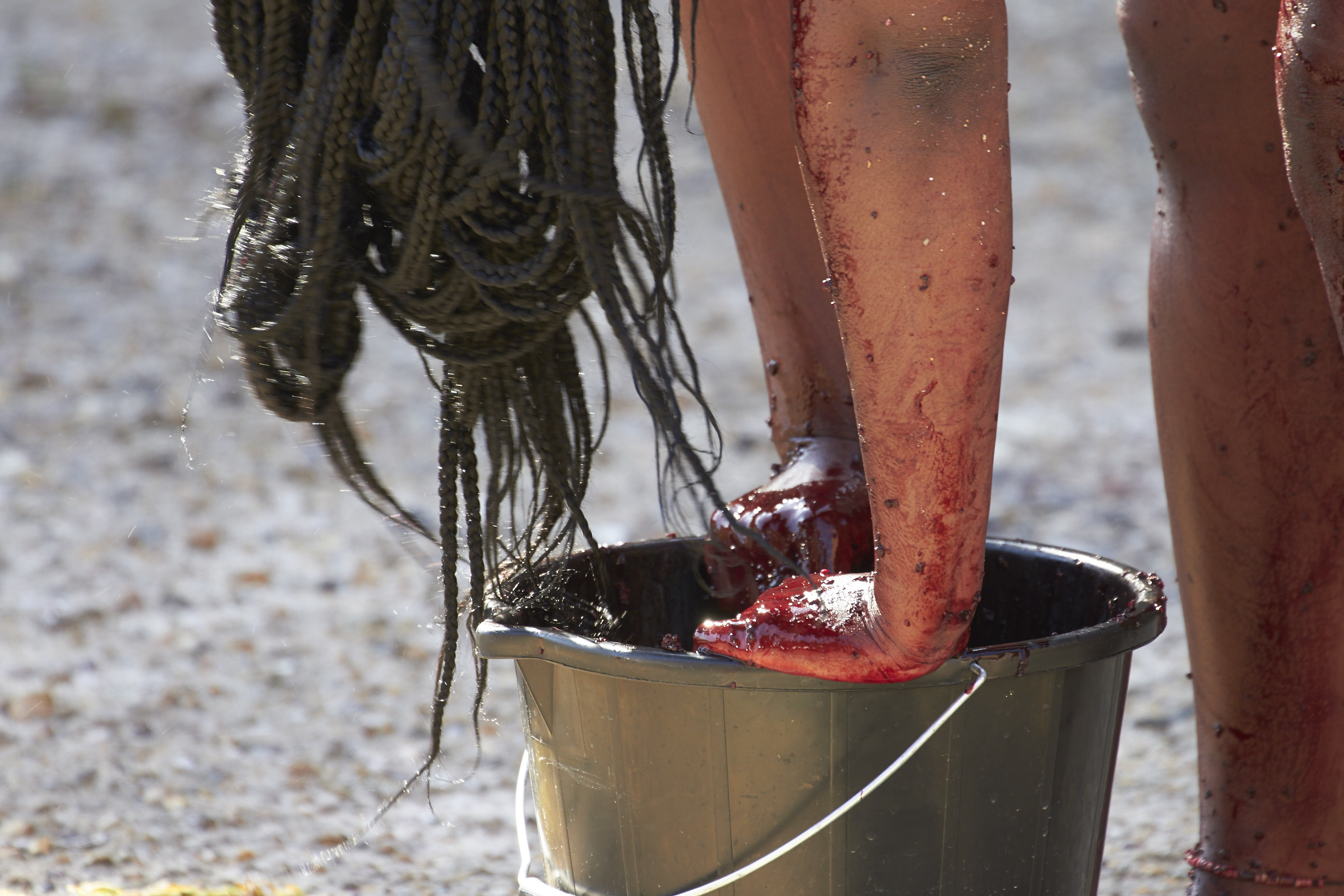Lubna Gem Arielle
Chinasa Vivian Ezugha
This text is one of various commissioned responses to SALVAGE Festival; a day of performance art on and around the coastline of Folkstone during the summer of 2019.
︎︎︎ about SALVAGE
Chinasa Vivian Ezugha, SALVAGE, 2019. Photo credit pending.
Sacred or taboo? Revered or repulsive? Comfort or danger? Rise or collapse? Oppressed or enlightened? Safety or concealment? Acts of sacrifice or honouring own divinity? Connection or destruction? Progress or plunder? Constantly on the edge of not knowing and so led to ask questions, to explore, to divine.
Vivian Chinasa Ezugha’s performance takes place in daylight, on an abandoned lot, boundaries set by metal fencing panels and the walls of disused buildings, overlooked by an occupied block of flats behind the gathered audience. The objects within the space are sparse – a fencing panel lying on the ground, a battered metal bucket and a piece of white voile tied to the fence. The artist wears only white briefs stained with a substance that appears to be blood which is also on her hands and smeared across her face. There is an immediate tension in the juxtaposition of this public space with private acts; the artist’s partial nudity and the allusion to menstrual blood, a strong societal taboo under the diktats of patriarchy. Misogynistic ideals objectifying women and denigrating their natural bodily functions are publicly flouted by the artist highlighting the dichotomy of attitudes towards menstrual blood between patriarchal and ancient goddess traditions. The former deeming it unclean, with frequent variations of banning women from religious places and contact with men or imposing menstrual seclusion rites forbidding women to see light, to touch water or the earth, and the latter regarding it as sacred, offering blood as a gift to nourish the earth.
Chinasa Ezugha’s performance is richly layered with ambiguities challenging patriarchy, colonialism and late capitalism and their consequences on our relationship to the earth and environment. A sense of discomfort runs throughout the work creating a space for reflection.
At times, the artist lies on the discarded fencing panel. On its first iteration, the gesture offers a moment’s reprieve from the intrinsic tension of the work’s set-up, a single freeze-frame of repose in an urban sunspot. Is this a claim to the space, an assertion of a right to be present? The artist repeats this gesture during the performance, sometimes extending her body, at others twisting. Is she making herself comfortable, stretching or is she uncomfortable and restless? Later, discomfort seems more palpable, as the panel leaves markings on her body, like branding. Does the cold metal separate her from the warmth of the earth? What of the markings left on the earth by the metal panel? From the environmental damage of extractive industries at its inception to its discarding and eventual disposal? What is the impact of isolating the consequences on the earth in constantly producing objects?
At other times, the artist moves the metal panel. Holding it vertically, she appears to attempt to climb it, although unsupported it will clearly collapse. An allegory for our times. When thrown, it clatters like a shaken cage and as she holds it up so that artist and audience are visible to one another through bars. Who is captive and who is protected?
The worn metal bucket contains the deep red substance with which Chinasa Ezugha periodically anoints her face and body. A vague notion of a pattern seems to emerge from the repetition of this gesture and induces a mild sense of comfort within the perpetual levels of uncertainty and ongoing tension in the work. As it does, the artist returns to the bucket, but this time shakes the contents over her head. As the substance pours over her and drips to the earth, it is clear that it contains berries. Their sweet smell fills the air, and again there is a glimmer of relief that this is perhaps berries and not blood, quickly followed by discomfort at this conditioned but invalid assumption that the juices of berries are more acceptable than those from the female body when both are equally of nature.
A piece of white voile hangs at the opening of the enclosed space. Early on in the performance, Chinasa Ezugha, with her eyes closed, has walked tentatively yet solidly to take this and press it against her face, leaving an imprint reminiscent of the shroud of Turin. At the end of the performance, she returns here and wraps the voile around her body like a sarong, stained with red fluids passing as eco-friendly tie-dye. A fleeting moment of small town normality. Now though, she moves out of the enclosure, briefly into the small disused garage by its side and then towards the road.
What will happen now as she steps into the ordinary world? Into the streets of Folkestone?
She goes unnoticed. In a seaside town, a woman in a sarong is not an unusual sight. How quickly we are covered by threads of human existence pulled taut through societal conditions and systemic constraints - compromising or concealing our conflicts, non-compliance, shame and the like. In Chinasa Ezugha’s work, we have witnessed alternative, arguably bolder choices to this apparent safety.
Vivian Chinasa Ezugha’s performance takes place in daylight, on an abandoned lot, boundaries set by metal fencing panels and the walls of disused buildings, overlooked by an occupied block of flats behind the gathered audience. The objects within the space are sparse – a fencing panel lying on the ground, a battered metal bucket and a piece of white voile tied to the fence. The artist wears only white briefs stained with a substance that appears to be blood which is also on her hands and smeared across her face. There is an immediate tension in the juxtaposition of this public space with private acts; the artist’s partial nudity and the allusion to menstrual blood, a strong societal taboo under the diktats of patriarchy. Misogynistic ideals objectifying women and denigrating their natural bodily functions are publicly flouted by the artist highlighting the dichotomy of attitudes towards menstrual blood between patriarchal and ancient goddess traditions. The former deeming it unclean, with frequent variations of banning women from religious places and contact with men or imposing menstrual seclusion rites forbidding women to see light, to touch water or the earth, and the latter regarding it as sacred, offering blood as a gift to nourish the earth.
Chinasa Ezugha’s performance is richly layered with ambiguities challenging patriarchy, colonialism and late capitalism and their consequences on our relationship to the earth and environment. A sense of discomfort runs throughout the work creating a space for reflection.
At times, the artist lies on the discarded fencing panel. On its first iteration, the gesture offers a moment’s reprieve from the intrinsic tension of the work’s set-up, a single freeze-frame of repose in an urban sunspot. Is this a claim to the space, an assertion of a right to be present? The artist repeats this gesture during the performance, sometimes extending her body, at others twisting. Is she making herself comfortable, stretching or is she uncomfortable and restless? Later, discomfort seems more palpable, as the panel leaves markings on her body, like branding. Does the cold metal separate her from the warmth of the earth? What of the markings left on the earth by the metal panel? From the environmental damage of extractive industries at its inception to its discarding and eventual disposal? What is the impact of isolating the consequences on the earth in constantly producing objects?
At other times, the artist moves the metal panel. Holding it vertically, she appears to attempt to climb it, although unsupported it will clearly collapse. An allegory for our times. When thrown, it clatters like a shaken cage and as she holds it up so that artist and audience are visible to one another through bars. Who is captive and who is protected?
The worn metal bucket contains the deep red substance with which Chinasa Ezugha periodically anoints her face and body. A vague notion of a pattern seems to emerge from the repetition of this gesture and induces a mild sense of comfort within the perpetual levels of uncertainty and ongoing tension in the work. As it does, the artist returns to the bucket, but this time shakes the contents over her head. As the substance pours over her and drips to the earth, it is clear that it contains berries. Their sweet smell fills the air, and again there is a glimmer of relief that this is perhaps berries and not blood, quickly followed by discomfort at this conditioned but invalid assumption that the juices of berries are more acceptable than those from the female body when both are equally of nature.
A piece of white voile hangs at the opening of the enclosed space. Early on in the performance, Chinasa Ezugha, with her eyes closed, has walked tentatively yet solidly to take this and press it against her face, leaving an imprint reminiscent of the shroud of Turin. At the end of the performance, she returns here and wraps the voile around her body like a sarong, stained with red fluids passing as eco-friendly tie-dye. A fleeting moment of small town normality. Now though, she moves out of the enclosure, briefly into the small disused garage by its side and then towards the road.
What will happen now as she steps into the ordinary world? Into the streets of Folkestone?
She goes unnoticed. In a seaside town, a woman in a sarong is not an unusual sight. How quickly we are covered by threads of human existence pulled taut through societal conditions and systemic constraints - compromising or concealing our conflicts, non-compliance, shame and the like. In Chinasa Ezugha’s work, we have witnessed alternative, arguably bolder choices to this apparent safety.





